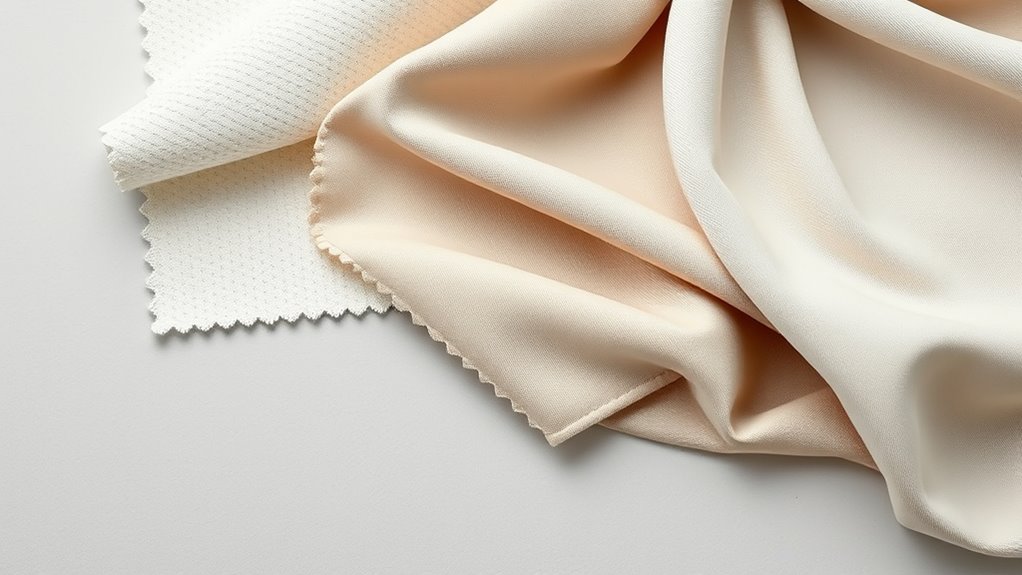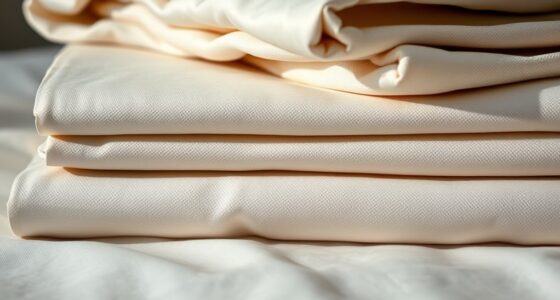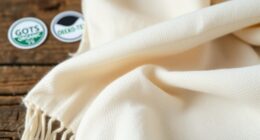When choosing lining fabric, consider how breathability, structure, and drape affect your garment. Breathable natural fibers like cotton or silk keep you comfortable, especially in warm weather. For added support and tailored looks, heavier linings provide structure, while lightweight options suit flowy, soft silhouettes. The right fabric weight and firmness balance comfort with style, ensuring your garment maintains its shape without feeling restrictive. Keep exploring these details to craft the perfect lining for your project.
Key Takeaways
- Breathability depends on natural fibers like cotton and silk, ideal for warm weather garments.
- Heavier linings provide more structure, supporting tailored or thicker outer fabrics.
- Lightweight linings offer soft drape, suitable for flowing, delicate outer fabrics like chiffon or silk.
- Synthetic and blended linings can enhance durability and moisture-wicking properties, affecting comfort.
- Matching lining weight and fabric type to the garment’s purpose ensures optimal comfort, shape, and style.

Selecting the right lining fabric is essential to guarantee your project looks polished and feels comfortable. One of the key factors to consider is fabric weight. Lining fabrics come in various weights, from lightweight chiffons to heavier satins, and your choice directly impacts the garment’s overall structure and feel. A lightweight lining is ideal for flowing garments or those meant to have a softer drape, offering breathability and ease of movement. Conversely, a heavier lining provides more support and structure, perfect for tailored jackets or structured skirts. Picking the appropriate fabric weight ensures your finished piece maintains its shape without feeling bulky or restrictive. Additionally, understanding the contrast ratio of your lining fabric can influence how vibrant or muted the final appearance of your garment will be under different lighting conditions.
Choosing the right lining weight ensures your garment maintains shape, comfort, and a polished look.
Color coordination is equally important when selecting lining fabric. You want your lining to complement your outer fabric seamlessly. For neutral or pastel-colored fabrics, a matching or slightly lighter shade often creates a clean, cohesive look. If your fabric is bold or patterned, opting for a neutral lining—like beige, black, or white—can prevent visual distraction and keep the focus on the outer design. When working with vibrant or richly colored fabrics, it’s wise to choose a lining that either matches the hue for a polished look or contrasts subtly to add depth. Proper color coordination not only enhances the aesthetic appeal but also ensures your lining doesn’t detract from the overall style.
In addition to weight and color, consider how the lining’s fabric weight interacts with the outer fabric. For example, a lightweight lining paired with a delicate chiffon or silk outer layer maintains a soft, flowing silhouette, while a heavier lining on a thick wool coat adds durability and structure. Think about the climate and how the garment will be worn; breathable linings made from natural fibers like cotton or silk are great for warm weather, whereas synthetic blends might work better in cooler conditions.
Ultimately, choosing the right lining fabric involves balancing fabric weight for structure and comfort, and color coordination for visual harmony. When you get these elements right, your project will not only look professional but also feel just right against your skin. Take your time to evaluate your outer fabric’s characteristics and your design goals. The effort you put into selecting thoughtful lining fabric will shine through in the finished piece, making it both beautiful and comfortable to wear.
Frequently Asked Questions
How Do I Care for Different Lining Fabrics?
You should follow specific maintenance tips for different lining material varieties. Always check the care label for washing instructions, as some linings require gentle cycles or hand washing, while others can be dry cleaned. For delicate fabrics like silk, avoid high heat and harsh detergents. Regularly inspect your lining for wear and tear, and store garments properly to maintain their quality. Proper care guarantees your lining fabric stays in great condition longer.
Can Lining Fabrics Be Eco-Friendly or Sustainable?
Your quest for eco-friendly textiles can transform your wardrobe into a force of nature! Many lining fabrics are now made from sustainable fashion options like organic cotton, hemp, and recycled polyester, reducing environmental impact. These eco-friendly textiles offer breathability, durability, and a soft drape, proving that you don’t have to compromise style for sustainability. Embracing sustainable lining fabrics helps protect the planet while keeping your wardrobe fresh and eco-conscious.
What Are Common Mistakes in Selecting Lining Materials?
When selecting lining materials, you often make mistakes like choosing fabrics that are too thick or too thin, which affects comfort and drape. You might also overlook color coordination, leading to mismatched or visible lining that clashes with the outer fabric. Always consider fabric thickness for the garment’s purpose and guarantee color harmony to create a polished look. Avoid these pitfalls to improve your sewing projects.
How Does Lining Fabric Affect Garment Weight?
When considering how lining fabric affects garment weight, you should think about fabric weight considerations and lining thickness choices. Thicker linings add more weight, making your garment feel heavier and potentially less comfortable, especially in warmer weather. Lighter linings help maintain a more breathable and lightweight feel, ideal for summer wear. Choosing the right lining thickness balances comfort and structure, ensuring your garment feels just right without adding unnecessary bulk.
Are There Allergy-Friendly Lining Options Available?
You’re wondering if allergy-friendly lining options exist. Yes, you can choose hypoallergenic options like plant-based linings that are gentle on sensitive skin. These alternatives reduce irritation and avoid common allergens found in synthetic fabrics. By selecting these eco-friendly, allergy-friendly linings, you guarantee comfort and safety while maintaining a stylish garment. Always check product labels for hypoallergenic certifications to make the best choice for sensitive skin.
Conclusion
As you select your lining fabric, remember that breathability, structure, and drape all work together—sometimes in unexpected ways. Coincidentally, the fabric you choose might just be the perfect match for your project’s unique needs, shaping the final look and feel more than you realize. Trust your instincts, and you’ll find that the right lining can unexpectedly elevate your creation, making every stitch and fold feel just right.









